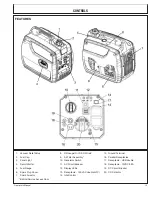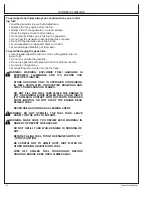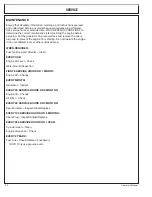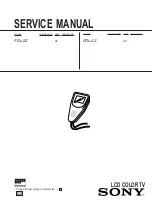
PREPARING THE GENERATOR
Operator’s Manual
17
AC USAGE
Do NOT overload the generator. Exceeding the rated power
of the generator can damage the generator and the electrical
devices connected to it.
Motor-driven devices require a large starting current. Make
sure that the total power requirement of these types of loads
does not exceed the rated power of the generator.
When the generator is used to power multiple loads or electric
appliances, start by connecting the appliance with the highest
starting power requirements, followed by the second highest
and ending with the lowest.
HIGH ALTITUDE KIT
At higher altitudes, the standard air-fuel mixture is too rich
and will cause decreased performance and increased fuel
consumption. A rich mixture will also foul the spark plug and
make starting difficult. Operation at higher altitudes for ex
-
tended periods of time may increase emissions.
Proper operation can be ensured by installing an altitude kit
when required. High altitude kits should be installed by a qual-
ified technician. Contact an authorized service provider if the
portable generator will be operated at altitudes greater than
3000 feet (0.9 km) above sea level.
Note: At elevations greater than 8000 feet above sea level, the
engine may experience decreased performance even with the
high altitude kit installed.
PRE-OPERATION
CHECK ENGINE OIL:
Before checking or refilling oil, be sure generator is located on
stable and level surface with engine stopped.
1. Open the right service door (1). Remove the oil level gauge
(2) and wipe clean.
2. Check the oil level by re-inserting the oil level gauge (do not
screw in tight).
3. If the oil level is low (4), add the recommended engine oil, using
the funnel supplied, until the oil level reaches the upper mark
(3) on the oil level gauge. Use the chart below to determine
which viscosity oil to use.
4. After adding oil, install and tighten the oil level gauge (2), and
close the service door (1).
Note: Non-detergent and 2-stroke engine oils will damage
the engine and must not be used.
CHECK FUEL LEVEL
1. Check the fuel level gauge (2).
2. If the fuel level is low, remove fuel cap (1).
3. Check the strainer. If the strainer is dirty, clean the strainer.
Refer to Fuel Tank Cap and Strainer – Clean for instructions.
4. Add fuel. The use of a fuel stabilizer is highly recommended
as the unit may sit for long periods of time before needed.
5. Install the fuel cap after fueling.
Recommended Lubricant Viscosities for Ambient
Temperature
Oil Viscosities
°C
°F
Min
Max
Min
Max
SAE 0W-40
-40
40
-40
104
SAE 5W-40
-30
50
-22
122
SAE 10W-30 -
18
40
0
104
SAE 15W-40
-10
50
14
122
2
2
3
4
1
1
2
Summary of Contents for GEN-2000-iMM1
Page 91: ...Manual del Operador 91 ...
















































